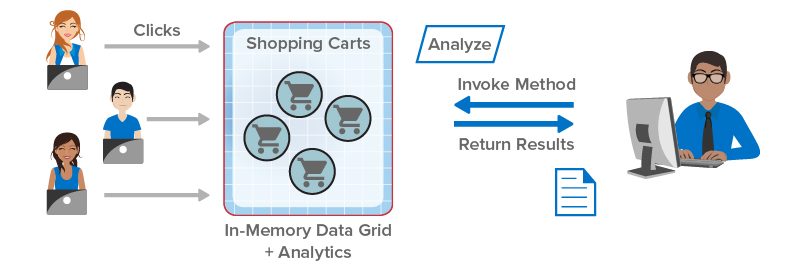ScaleOut StateServer® Pro Adds Analytics to In-Memory Data Grids
In-Memory Data Grids for Fast-Changing Data
For more than fifteen years, ScaleOut StateServer® has demonstrated technology leadership as an in-memory data grid (IMDG) and distributed cache. Designed to help scalable applications deliver high performance, it stores live, fast-changing data in memory (DRAM) for fast updates and retrieval. By transparently distributing stored objects across a cluster of servers (physical or virtual), it automatically scales performance for fast-growing workloads and maintains consistently low access latency. Typical uses include storing session-state and ecommerce shopping carts, product descriptions, airline reservations, financial portfolios, news stories, online learning data, and many others.
From its inception, the design philosophy behind ScaleOut StateServer has been to simultaneously maximize both performance and ease of use. Because IMDGs have complex internal mechanisms, they need to automate them as much as possible so that the developer can just focus on application concerns and not on the inner workings of the IMDG. For this reason, the product incorporates features such as automatic discovery of servers, transparent load-balancing when servers are added to the cluster or removed, automatic data replication for high availability with transparent placement of replicas, quorum-based updating of replicas to ensure consistency, integrated client libraries, and coherent client-side caching. The net effect is that applications maintain a straightforward view of the IMDG as a unified key/value store for serialized application objects.
The Challenges with Parallel Queries
Although IMDGs are optimized for key-based access, applications often need to retrieve groups of objects with matching properties. For example, if an application is storing shopping carts, it might be useful to find all shopping carts with a total value that exceeds a specified threshold so that these shoppers can be given special attention. To this end, ScaleOut StateServer incorporates a property-based, distributed query API that returns a collection of matching objects. To simplify development for .NET applications, it uses Microsoft’s language integrated query (LINQ) to specify queries. (Java applications use a similar mechanism.)
Queries in an IMDG can create interesting performance challenges. Because IMDGs have highly scalable storage capacity, they can easily return large numbers of matching objects to the client application, and this leads to network bottlenecks transferring large amounts of data from the IMDG back to the client. Once all objects are delivered, the client is then faced with the task of analyzing potentially huge numbers of objects. This can saturate the client’s CPU and delay responses, as illustrated in the following diagram:

ScaleOut StateServer Pro: Integrated Data Analytics
To address these challenges, ScaleOut Software has introduced ScaleOut StateServer Pro, an advanced version of ScaleOut StateServer that integrates data analytics within the IMDG. Instead of querying objects from the IMDG and analyzing them in the client, applications can now simply run this analysis within the IMDG itself using APIs available in ScaleOut StateServer Pro. Because all the work is performed with the IMDG, this has the two-fold advantage of offloading both the network and the client’s CPU. It also transparently makes use of the IMDG’s scalable computing resources to accelerate the analysis.
Take a look at how integrated data analytics can help client applications. In the following illustration, the client library sends the application’s analysis method (“Analyze”) to the IMDG for execution in parallel on all shopping carts selected by a query. The results are combined within the IMDG and returned to the application:

Keeping with the design philosophy of maximizing both performance and ease of use, ScaleOut StateServer Pro lets developers easily construct data analytics by specifying an object-oriented method that analyzes each matching object selected by a query and a second method for combining the results. In .NET applications, this data-parallel execution structure can be described using a distributed version of Microsoft’s popular Parallel.ForEach API, which ScaleOut StateServer Pro integrates with LINQ query. Application code is automatically shipped by the client library to the IMDG for execution and runs fully in parallel across all servers for maximum performance.
Consider the above example of querying shopping carts exceeding a threshold value. Suppose the application’s goal is to periodically analyze high value shopping carts to make upsell offers based on the contents of each cart. Instead of querying the IMDG and returning thousands of shopping carts to the client, the application can implement a method which analyzes these carts within the IMDG to determine which carts should receive upsell offers (and possibly determine which upsell offers to make). This analysis runs in parallel within the IMDG and then returns its results to the client for further action. This dramatically reduces the workload on the network and client, and it ensures consistently high performance.
Summing Up: Extracting Maximum Value from an IMDG
Since their inception, IMDGs have to a large extent been underutilized by viewing them as passive key/value stores. Because they are actually designed as a data-parallel execution platform, they can do much more than just store and serve memory-hosted, live data. They also can perform analysis quickly and efficiently — where the data lives.
Taking full advantage of this powerful capability requires just a shift in thinking about where application work should be performed. In many cases, it’s a much better choice to analyze data within the IMDG instead of transferring it to the client for analysis. ScaleOut StateServer Pro makes it easy to do just that, and it delivers fast, scalable performance. Now developers can finally extract full value from their IMDGs.
